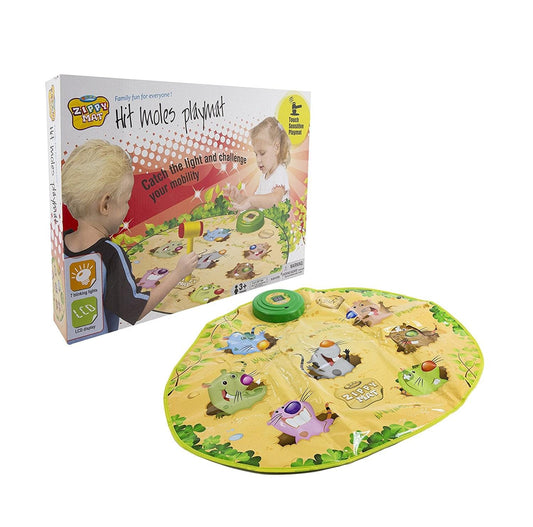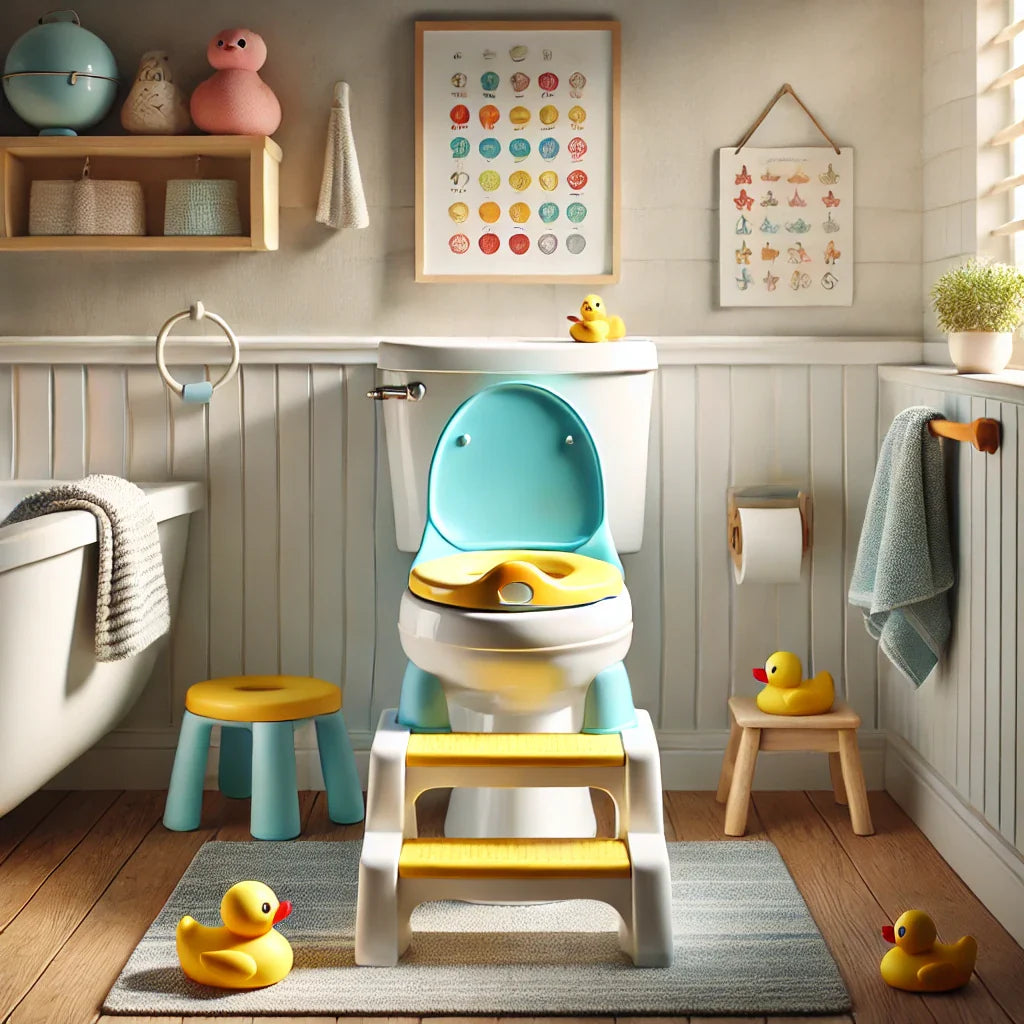Introduction
Why Timing Is Crucial in Toilet Training
Toilet training is one of those parenting milestones that feels both exciting and intimidating. Getting your toddler out of nappies is a huge step—but the truth is, timing is everything. Start too soon and your toddler may resist. Wait too long, and you may miss a golden opportunity when they’re eager and receptive.
Many parents wonder: When is the right time? The answer lies not just in age, but in observing your child's behavior and readiness cues. Every child develops at their own pace, and recognizing these signs can make a huge difference in how smooth or stressful the experience will be.
Just as important as timing is having the right gear—specifically, a good toddler toilet training seat. It’s the bridge between diapers and full toilet independence. And trust us, having the right seat can seriously cut down on tears, tantrums, and messes (for both of you!).
Role of the Right Toddler Toilet Training Seat
A toddler toilet training seat isn’t just a fancy bathroom accessory—it’s a key part of helping your child feel secure, comfortable, and in control during potty training. These seats are designed to fit on top of a regular toilet, shrinking the seat size so your toddler doesn’t fall in or feel unstable.
Why does this matter so much? Because toddlers are learning more than just where to go—they’re building confidence. The right seat provides:
-
Safety and stability
-
Proper posture
-
Comfort for longer sits
-
Encouragement through independence
Parents across Australia love the Playkitchen Toddler Toilet Training Seat with Ladder for exactly these reasons. It’s supportive, secure, and gives your toddler the confidence to climb, sit, and flush all by themselves.
Before diving into how to train, let’s first look at what exactly makes a toddler toilet training seat unique.
What is a Toddler Toilet Training Seat?
Features Designed for Toddlers
A toddler toilet training seat is a specially designed insert that sits on top of a regular toilet. It helps reduce the size of the toilet bowl opening and usually includes additional safety and comfort features like:
-
Non-slip base
-
Soft, padded seat
-
Side handles for balance
-
Splash guard (especially useful for boys)
-
Backrest for support
Many modern seats also feature attached ladders, allowing your toddler to climb up and down without your help. This not only encourages independence but also reduces your need to lift them every time—win-win!
Types of Training Seats (Standard, Ladder, Portable)
There are a few styles of toddler toilet training seats, each with its own benefits:
-
Standard Toilet Seat Reducers: These are simple, small seats that fit on top of your toilet. They’re great for older toddlers who are already confident.
-
Ladder Step-Up Seats: These come with a built-in ladder and are ideal for younger or more cautious kids. The Playkitchen model is a great example of this type.
-
Portable or Travel Seats: Compact and foldable, these are perfect for road trips, daycare, or public restrooms.
Each type has its place, but for home use, ladder seats are often the best all-around choice. They combine the functionality of a reducer with the independence of a step stool.
Benefits Over Traditional Potty Chairs
Potty chairs are the old-school approach to toilet training. While they’re useful for some families, they do come with drawbacks—mainly that they require an extra step to empty and clean, and your child still has to learn to use the adult toilet later on.
A toddler toilet training seat, on the other hand:
-
Helps kids get used to the real toilet from the beginning.
-
Is cleaner and more hygienic (just flush and go).
-
Encourages quicker transitions to toilet independence.
-
Saves space in the bathroom.
Plus, if your toddler sees you using the toilet and gets curious, a training seat makes it easy to jump right into mimicking you—which toddlers love to do!
When to Start Toilet Training
Best Age Range to Begin
There’s no “perfect” age for every child, but most toddlers are ready to begin toilet training between 18 months and 3 years old. Some may be ready earlier, while others might need more time.
Rather than relying on age alone, watch your toddler’s developmental cues. Readiness matters more than hitting a specific milestone. Starting too early can lead to frustration, resistance, or regression.
Physical and Emotional Signs of Readiness
Here are some key signs that your toddler might be ready to start using a toilet training seat:
-
They stay dry for longer periods—2 hours or more.
-
They show interest in the toilet or want to watch you.
-
They tell you before or after they go in their diaper.
-
They can follow simple instructions (e.g., “sit down,” “pull up your pants”).
-
They dislike dirty nappies or ask to be changed immediately.
-
They can walk to the bathroom and sit down without help.
When these signs line up, it’s usually a great time to introduce them to the toilet seat and start building a routine.
Why Rushing Can Backfire
Parents often feel pressure to start training early, especially when they hear stories of 18-month-olds ditching diapers in a weekend. But here’s the truth: rushing rarely works.
If your toddler isn’t developmentally ready, forcing them to train can:
-
Create fear or resentment toward the toilet.
-
Cause them to hold their pee or poop, leading to constipation.
-
Turn training into a power struggle.
-
Set you back weeks or even months.
Instead, follow your child’s lead. Watch for the signs. When they’re ready—and you’re prepared with the right tools—it becomes a much smoother and more positive journey.
Key Signs Your Toddler is Ready
Stays Dry for Longer Periods
One of the first and most obvious signs of potty readiness is longer dry spells. If your toddler is staying dry for at least two hours during the day or waking up from naps with a dry nappy, it means their bladder control is developing—and that’s a big deal!
This shows their body is capable of holding pee long enough to recognize the urge to go, which is essential for successful toilet training. Start noting how often you change nappies and track those dry stretches—they're your first green light.
Expresses Interest in the Bathroom
Toddlers are naturally curious. If they start following you into the bathroom, asking questions, or trying to imitate what you do, that’s a huge readiness cue. They’re watching and learning—and might even try to sit on the toilet (fully dressed) just to copy you.
This is the perfect time to introduce a toddler toilet training seat, even if it’s just for practice. Let them explore it, sit on it with their clothes on, and get comfortable with the idea. The more familiar it feels, the less scary it will be when they start using it for real.
Can Follow Simple Instructions
Potty training isn’t just physical—it’s also cognitive. Your child needs to understand what’s happening and be able to follow basic steps like:
-
“Let’s go to the toilet.”
-
“Pull down your pants.”
-
“Sit on the seat.”
-
“Now we flush and wash hands.”
If your toddler can follow these kinds of directions, they’re developmentally ready to start. The training process will be a lot smoother because they can understand routines and build habits more easily.
Dislikes Dirty Nappies or Wants Undies
Another major clue? Your toddler starts telling you when they’ve pooped or demands to be changed immediately after. Some kids will even start removing their nappies or asking for underwear because they don’t like the feeling of being wet or soiled.
This awareness is a turning point. It means your child is recognizing the discomfort and starting to prefer being clean and dry—just like a big kid.
When this happens, it's a great time to introduce potty routines and give them a training seat like the Playkitchen Toddler Toilet Training Seat. The excitement of “graduating” to the toilet and wearing undies can be a huge motivator!
How to Prepare for Toilet Training
Choosing the Right Toddler Toilet Training Seat
Investing in the right seat can make all the difference. Look for a training seat that is comfortable, safe, and toddler-friendly. Features to consider include:
-
Soft padding for comfort
-
Handles for balance
-
Non-slip base or ladder for stability
-
Splash guard to reduce messes
-
Adjustable step height for growth
One of the most recommended options in Australia is the Playkitchen Potty Trainer with Ladder. It checks all the boxes: safety, comfort, and ease of use. Plus, the built-in ladder promotes independence, so your toddler can learn to go on their own—building confidence every step of the way.
Creating a Positive Bathroom Environment
Your toddler’s training environment matters more than you might think. A welcoming, positive bathroom setup helps ease nerves and builds trust in the process.
Try these tips:
-
Keep a basket of books or toys near the toilet.
-
Let your child decorate their training seat with stickers or pick their favorite color.
-
Add a stool for hand washing, so the whole process feels accessible.
-
Practice flushing together, even if they haven’t gone—this helps normalize the sounds and steps.
The more fun and familiar it is, the less stressful it’ll feel for everyone involved.
Setting Realistic Expectations
Potty training is a journey, not a sprint. Expecting overnight results or comparing your child to others can set you up for frustration.
Here’s what to remember:
-
Accidents are normal.
-
Every child trains at their own pace.
-
Some regress after getting started—it’s okay.
-
Stay calm and encouraging, even when it’s tough.
Set small goals and celebrate progress—not perfection. With the right attitude and the right tools (like a well-designed toddler toilet training seat), you’ll both come through this stage with a lot less stress.
Step-by-Step Toilet Training Tips
Introduce the Concept Gradually
One of the best ways to start toilet training is to ease your toddler into it. Don’t just suddenly take away the nappies and expect them to “get it.” Instead, build up slowly:
-
Let them watch you (yes, really!)—toddlers love to imitate.
-
Talk about what you’re doing when you go to the toilet.
-
Introduce the toilet training seat before you expect them to use it.
-
Let them sit fully dressed at first—no pressure, just exploration.
-
Celebrate little wins—like sitting, flushing, or even washing their hands after trying.
This slow introduction helps your toddler feel safe and familiar with the process. It also gives them a sense of control, which is key to successful training.
Establish a Routine
Toddlers thrive on routine. Having set times during the day to sit on the toilet—even if they don’t go—creates predictability and helps them understand when their body might need to use the toilet.
Here are some ideal times to try:
-
Right after waking up
-
After meals or snacks
-
Before naps and bedtime
-
After a long play session
Use verbal cues like “Let’s check if you need a wee” or “Time for a toilet break!” This sets the tone without putting too much pressure on results.
If your child is using a seat like the Playkitchen Toilet Training Seat with Ladder, encourage them to climb up themselves as part of the routine. It turns a task into a toddler triumph.
Use Praise and Positive Reinforcement
Toilet training is just as much about building confidence as it is about learning when and how to go. That’s why positive reinforcement is so effective.
Here’s what works:
-
Praise attempts, not just results: “Great job sitting on the toilet!”
-
Stickers or reward charts: These offer visual encouragement and keep track of progress.
-
Sing songs or do a ‘potty dance’ after successful attempts.
-
Let them pick their undies as a reward for trying.
Avoid punishments or negative reactions during accidents. Instead, reassure them with phrases like, “Oops! That’s okay, we’ll try again next time.”
A calm, upbeat attitude goes a long way—and using a reliable, safe training seat boosts your toddler’s sense of achievement even more.
Common Toilet Training Mistakes to Avoid
Comparing Your Child to Others
It’s easy to feel pressure when other kids in your mum’s group are potty trained and your toddler is still rocking nappies. But remember—every child develops differently.
Some kids are ready at 18 months. Others not until 3 or later. Comparing only leads to unnecessary stress.
Instead, focus on your child’s signs of readiness, and celebrate their unique progress. If they’re using their toddler toilet training seat with curiosity or consistency, that’s a win—no matter what age they are.
Getting Frustrated with Accidents
Accidents are part of the process. Your child is learning a new life skill that involves body awareness, coordination, and communication. It’s a lot!
Reacting with anger or frustration can create fear and resistance. Instead, keep a spare change of clothes handy and respond calmly. Use accidents as teaching moments, not punishments.
Statements like “Let’s clean up together” or “Next time we’ll try the toilet again” reinforce teamwork and learning.
Skipping the Preparation Phase
Going from nappies to the toilet overnight might work for a handful of kids—but most need gradual exposure and a plan.
If you jump into toilet training without prepping your toddler with tools like:
-
A comfortable training seat
-
Familiarity with bathroom routines
-
Positive potty-related conversations
...you risk turning it into a stressful, uphill battle.
Proper prep makes all the difference. That’s why parents who start by introducing tools like the Playkitchen ladder-style seat often report quicker, smoother transitions.
Why the Playkitchen Toddler Toilet Training Seat is a Must-Have
Standout Features and Safety
When it comes to choosing the right toddler toilet training seat, not all products are created equal. The Playkitchen Potty Trainer Toilet Seat with Ladder Step-Up stands out for several reasons:
-
Built-in ladder with adjustable steps helps toddlers climb up safely.
-
Non-slip feet and side handles offer maximum stability.
-
Soft, cushioned seat with ergonomic design for longer potty sessions.
-
Fits most standard toilets in Australia.
-
Folds easily for compact storage—perfect for smaller bathrooms.
It’s thoughtfully designed with both toddlers and parents in mind, making it one of the best choices for families starting the potty training journey.
Parent Reviews
Aussie parents love how the Playkitchen seat takes the pressure off:
“My son refused to sit on the big toilet until we got this ladder seat. Now he climbs up by himself and is so proud!”
— Emily R., Brisbane
“We used a basic potty chair at first, but the Playkitchen seat made the switch to the toilet so much easier. Total game-changer.”
— James K., Sydney
These real-life success stories show how much of a difference the right seat can make.
Where to Buy in Australia
You can order the Playkitchen toilet training seat directly from their official website here:
👉 Shop Now – Playkitchen Toilet Seat with Ladder
They offer fast shipping, secure checkout, and a wide range of other kid-friendly products to support your parenting journey.
FAQs About Toddler Toilet Training Seats
Q1: What age should I start using a toddler toilet training seat?
Most toddlers are ready to start between 18 months and 3 years old, depending on their development. Look for signs like staying dry for longer periods, showing interest in the toilet, and being able to follow simple instructions.
Q2: Is a toilet training seat better than a potty chair?
It depends on your child. Toilet training seats are great for toddlers ready to use the actual toilet and can shorten the training process. Potty chairs may work better for younger or more hesitant kids but eventually require a transition to the toilet.
Q3: Can my toddler use the toilet training seat independently?
Yes! Especially models with built-in ladders like the Playkitchen Step-Up Toilet Seat. These encourage independence by letting your toddler climb up and sit down without help (supervised, of course).
Q4: Are toddler toilet seats hygienic?
Absolutely. Since they direct waste into the toilet, there’s no bowl to clean like with potty chairs. Most seats are made of smooth, non-porous materials that are easy to wipe down after use.
Q5: How do I make my toddler comfortable using the training seat?
Introduce it gently, let them sit on it fully dressed at first, and make it part of your daily routine. Choose a soft, ergonomic seat with back support, and celebrate every small win with praise or rewards.
Conclusion: Set Your Toddler Up for Toilet Success
Toilet training is a huge step for toddlers—and for parents. With the right timing, the right attitude, and the right tools, this milestone can be less messy, less stressful, and even enjoyable.
Pay attention to your child’s readiness signs, introduce potty time gradually, and set up a consistent routine. Most importantly, invest in a quality toddler toilet training seat that provides comfort, safety, and independence.
Our top recommendation? The Playkitchen Potty Trainer with Ladder Step-Up. It’s the ultimate confidence booster for little ones and a total sanity-saver for parents.
With a little patience, some encouragement, and the right gear, your toddler will be proudly flushing their way into the next stage of growing up.



